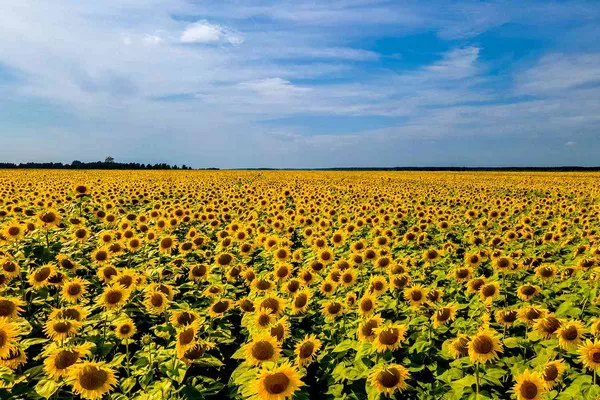Sunflower seeds, those nutritious kernels encased within the bright and cheery flower heads of Helianthus annuus, have a history as rich and diverse as their culinary uses today. From their humble beginnings in the Americas to their global spread and popularity, the journey of sunflower seeds spans centuries and continents, intertwining agriculture, culture, and commerce. This article delves into the origins of sunflower seeds, exploring their early cultivation, cultural significance, and their transformation into a global commodity.
The Native Roots: Early Cultivation in the Americas
Sunflowers are native to North and Central America, with archaeological evidence suggesting their domestication dates back to 3000 BCE in what is now the southern United States. Native American tribes such as the Aztecs and the Incas were among the first to cultivate sunflowers for both their seeds and oil. They not only utilized sunflower seeds as a nutritious snack but also pressed them to extract oil for cooking and medicinal purposes.
The wild sunflower, with its smaller seeds and multiple stems, was selectively bred over time by indigenous peoples to enhance seed size and yield, leading to the development of the larger-seeded sunflower varieties we recognize today. The plant’s ability to thrive in diverse climates and soils made it a valuable crop across different regions of the Americas, from the Great Plains to the Andes Mountains.
Spread Across Continents: Introduction to Europe and Beyond
The first documented introduction of sunflowers to Europe occurred in the early 16th century when Spanish explorers brought them back from the Americas. Initially regarded as ornamental plants for their striking flower heads, European botanists and gardeners soon recognized the potential of sunflowers as a crop.
By the 18th century, Russian farmers had begun large-scale cultivation of sunflowers for both their seeds and oil. The plant’s adaptability to the Russian climate and its high yield in oil production contributed significantly to its spread across Europe and eventually to other parts of the world.
Evolution of Cultivation Techniques and Industrialization
The 19th century marked a turning point for sunflower cultivation with advancements in agricultural practices and the industrialization of oil extraction methods. Russian and Ukrainian farmers pioneered hybridization techniques to improve sunflower yields, leading to the development of high-oil-content varieties that were well-suited for commercial oil production.
In the early 20th century, the United States emerged as a major producer of sunflower seeds, particularly in states such as North Dakota and South Dakota, where the crop thrived in the prairie climate. The establishment of processing facilities for sunflower oil further boosted its economic significance, solidifying its place as a valuable agricultural commodity.
Cultural Significance and Symbolism
Beyond its agricultural and economic importance, sunflowers hold cultural significance in various societies around the world. In Native American cultures, sunflowers symbolized harvest, sustenance, and spirituality, often featuring in ceremonies and rituals. The flower’s association with warmth, positivity, and vitality has made it a popular motif in art, literature, and folklore globally.
In Slavic folklore, for instance, the sunflower is associated with the sun deity and is seen as a symbol of fertility and good luck. Vincent van Gogh’s famous series of paintings depicting sunflowers captured their essence as a symbol of hope and beauty in the face of adversity, reflecting their enduring cultural appeal.
Modern-Day Production and Consumption
Today, sunflower seeds are cultivated on every continent except Antarctica, with Ukraine, Russia, Argentina, and the United States leading global production. The seeds are not only consumed as a nutritious snack in their roasted and salted form but also used in baking, cooking, and as ingredients in various culinary dishes.
Sunflower oil, extracted from the seeds, is prized for its light flavor, high smoke point, and nutritional benefits, making it a popular choice for cooking oils worldwide. The oil is used in salad dressings, frying, and food processing, contributing to its widespread demand in both domestic and industrial kitchens.
See Also: How Do Sunflowers Get Energy?
Environmental Impact and Sustainability
The cultivation of sunflowers offers several environmental benefits, including soil enrichment through crop rotation, biodiversity support for pollinators, and carbon sequestration. Sunflower plants have deep root systems that help improve soil structure and water retention, making them suitable for sustainable agriculture practices.
The economic significance of sunflower cultivation extends beyond food and cooking oil production. Sunflower meal, a byproduct of oil extraction, is used as a high-protein feed for livestock, contributing to the agricultural economy and food supply chain.
Future Prospects and Innovations
Looking ahead, ongoing research and innovation in sunflower genetics aim to enhance crop resilience to climate change, improve yield potential, and develop varieties with enhanced nutritional profiles. Biotechnological advancements offer opportunities to optimize sunflower traits such as disease resistance, drought tolerance, and oil composition, ensuring the crop’s continued relevance in global agriculture.
Consumer demand for healthy, natural foods continues to drive innovation in sunflower-based products, including snacks, spreads, and functional foods enriched with sunflower-derived ingredients. The versatility of sunflower seeds as a nutritious and sustainable food source positions them favorably in the growing market for plant-based foods and ingredients.
Conclusion
The journey of sunflower seeds from their origins in the Americas to their global cultivation and consumption is a testament to human ingenuity, cultural exchange, and agricultural innovation. From their humble beginnings as a wild plant to becoming a staple crop worldwide, sunflowers have left an indelible mark on agriculture, cuisine, and culture.
As we continue to explore and harness the potential of sunflowers, both as a nutritious food source and an agricultural commodity, their story serves as a reminder of the interconnectedness of global food systems and the importance of sustainable practices in securing our future food supply.
In conclusion, sunflower seeds not only nourish our bodies but also enrich our understanding of agricultural history and cultural diversity. As we look to the future, the sunflower remains a beacon of resilience and promise in our quest for a sustainable and food-secure world.


